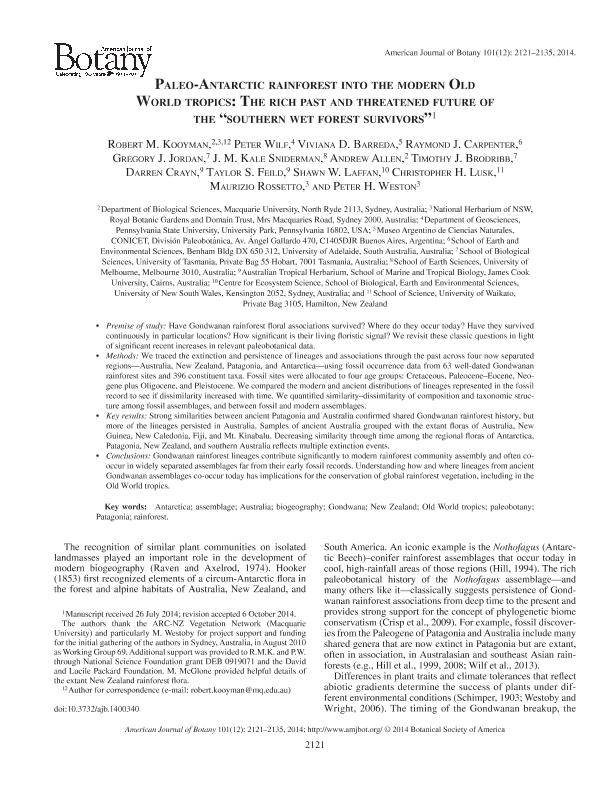Mostrar el registro sencillo del ítem
dc.contributor.author
Kooyman, Robert M.
dc.contributor.author
Wilf, Peter
dc.contributor.author
Barreda, Viviana Dora

dc.contributor.author
Carpenter, Raymond J.
dc.contributor.author
Jordan, Gregory J.
dc.contributor.author
Sniderman, J. M. Kale
dc.contributor.author
Allen, Andrew
dc.contributor.author
Brodribb, Timothy J.
dc.contributor.author
Crayn, Darren
dc.contributor.author
Feild, Taylor S.
dc.contributor.author
Laffan, Shawn W.
dc.contributor.author
Lusk, Christopher H.
dc.contributor.author
Rossetto, Maurizio
dc.contributor.author
Weston, Peter H.
dc.date.available
2017-12-06T21:42:33Z
dc.date.issued
2014-11
dc.identifier.citation
Kooyman, Robert M.; Wilf, Peter; Barreda, Viviana Dora; Carpenter, Raymond J.; Jordan, Gregory J.; et al.; Paleo-Antarctic rainforest into the modern Old World tropics: The rich past and threatened future of the “southern wet forest survivors”; Botanical Society of America; American Journal of Botany; 112; 1; 11-2014; 2121-2135
dc.identifier.issn
0002-9122
dc.identifier.uri
http://hdl.handle.net/11336/29897
dc.description.abstract
Premise of study: Have Gondwanan rainforest floral associations survived? Where do they occur today? Have they survived continuously in particular locations? How significant is their living floristic signal? We revisit these classic questions in light of significant recent increases in relevant paleobotanical data. Methods: We traced the extinction and persistence of lineages and associations through the past across four now separated regions—Australia, New Zealand, Patagonia, and Antarctica—using fossil occurrence data from 63 well-dated Gondwanan rainforest sites and 396 constituent taxa. Fossil sites were allocated to four age groups: Cretaceous, Paleocene–Eocene, Neogene plus Oligocene, and Pleistocene. We compared the modern and ancient distributions of lineages represented in the fossil record to see if dissimilarity increased with time. We quantified similarity–dissimilarity of composition and taxonomic structure among fossil assemblages, and between fossil and modern assemblages. Key results: Strong similarities between ancient Patagonia and Australia confirmed shared Gondwanan rainforest history, but more of the lineages persisted in Australia. Samples of ancient Australia grouped with the extant floras of Australia, New Guinea, New Caledonia, Fiji, and Mt. Kinabalu. Decreasing similarity through time among the regional floras of Antarctica, Patagonia, New Zealand, and southern Australia reflects multiple extinction events. Conclusions: Gondwanan rainforest lineages contribute significantly to modern rainforest community assembly and often co-occur in widely separated assemblages far from their early fossil records. Understanding how and where lineages from ancient Gondwanan assemblages co-occur today has implications for the conservation of global rainforest vegetation, including in the Old World tropics.
dc.format
application/pdf
dc.language.iso
eng
dc.publisher
Botanical Society of America

dc.rights
info:eu-repo/semantics/openAccess
dc.rights.uri
https://creativecommons.org/licenses/by-nc-sa/2.5/ar/
dc.subject
Palaeobotany
dc.subject
Gondwana
dc.subject
Biogeography
dc.subject
Rainforests
dc.subject.classification
Meteorología y Ciencias Atmosféricas

dc.subject.classification
Ciencias de la Tierra y relacionadas con el Medio Ambiente

dc.subject.classification
CIENCIAS NATURALES Y EXACTAS

dc.title
Paleo-Antarctic rainforest into the modern Old World tropics: The rich past and threatened future of the “southern wet forest survivors”
dc.type
info:eu-repo/semantics/article
dc.type
info:ar-repo/semantics/artículo
dc.type
info:eu-repo/semantics/publishedVersion
dc.date.updated
2017-12-04T20:04:07Z
dc.journal.volume
112
dc.journal.number
1
dc.journal.pagination
2121-2135
dc.journal.pais
Estados Unidos

dc.description.fil
Fil: Kooyman, Robert M.. Macquarie University; Australia. Royal Botanic Gardens and Domain Trust; Australia
dc.description.fil
Fil: Wilf, Peter. State University of Pennsylvania; Estados Unidos
dc.description.fil
Fil: Barreda, Viviana Dora. Consejo Nacional de Investigaciones Científicas y Técnicas. Oficina de Coordinación Administrativa Parque Centenario. Museo Argentino de Ciencias Naturales "Bernardino Rivadavia"; Argentina
dc.description.fil
Fil: Carpenter, Raymond J.. University of Adelaide; Australia
dc.description.fil
Fil: Jordan, Gregory J.. University of Tasmania; Australia
dc.description.fil
Fil: Sniderman, J. M. Kale. The University of Melbourne; Australia
dc.description.fil
Fil: Allen, Andrew. Macquarie University; Australia
dc.description.fil
Fil: Brodribb, Timothy J.. University of Tasmania; Australia
dc.description.fil
Fil: Crayn, Darren. James Cook University; Australia
dc.description.fil
Fil: Feild, Taylor S.. James Cook University; Australia
dc.description.fil
Fil: Laffan, Shawn W.. University of New South Wales; Australia
dc.description.fil
Fil: Lusk, Christopher H.. University of Waikato; Nueva Zelanda
dc.description.fil
Fil: Rossetto, Maurizio. Royal Botanic Gardens and Domain Trust; Australia
dc.description.fil
Fil: Weston, Peter H.. Royal Botanic Gardens and Domain Trust; Australia
dc.journal.title
American Journal of Botany

dc.relation.alternativeid
info:eu-repo/semantics/altIdentifier/doi/http://dx.doi.org/10.3732/ajb.1400340
dc.relation.alternativeid
info:eu-repo/semantics/altIdentifier/url/http://www.amjbot.org/content/101/12/2121
Archivos asociados
